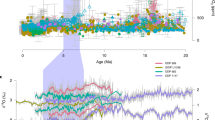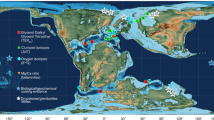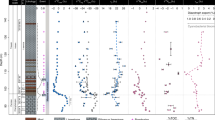Abstract
The greenhouse-to-icehouse climate transition from the Eocene into the Oligocene is well documented by sea surface temperature records from the southwest Pacific and Antarctic margin, which show evidence of pronounced long-term cooling. However, identification of a driving mechanism depends on a better understanding of whether this cooling was also present in terrestrial settings. Here, we present a semi-continuous terrestrial temperature record spanning from the middle Eocene to the early Oligocene (~41–33 million years ago), using bacterial molecular fossils (biomarkers) preserved in a sequence of southeast Australian lignites. Our results show that mean annual temperatures in southeast Australia gradually declined from ~27 °C (±4.7 °C) during the middle Eocene to ~22–24 °C (±4.7 °C) during the late Eocene, followed by a ~2.4 °C-step cooling across the Eocene/Oligocene boundary. This trend is comparable to other temperature records in the Southern Hemisphere, suggesting a common driving mechanism, likely \(p{{\rm{CO}}_{2}}\). We corroborate these results with a suite of climate model simulations demonstrating that only simulations including a decline in \(p{{\rm{CO}}_{2}}\) lead to a cooling in southeast Australia consistent with our proxy record. Our data form an important benchmark for testing climate model performance, sea–land interaction and climatic forcings at the onset of a major Antarctic glaciation.
This is a preview of subscription content, access via your institution
Access options
Access Nature and 54 other Nature Portfolio journals
Get Nature+, our best-value online-access subscription
$29.99 / 30 days
cancel any time
Subscribe to this journal
Receive 12 print issues and online access
$259.00 per year
only $21.58 per issue
Buy this article
- Purchase on Springer Link
- Instant access to full article PDF
Prices may be subject to local taxes which are calculated during checkout



Similar content being viewed by others
Data availability
All of the lignite data supporting the findings of this study and the compilation of previously published SST records used in Fig. 2 and Extended Data Fig. 3 are available in Supplementary Data 1. All data are available via PANGAEA at https://doi.org/10.1594/PANGAEA.933176 and the model simulation data are available via the freely accessible Bristol Research Initiative for the Dynamic Global Environment server at https://www.paleo.bristol.ac.uk/ummodel/scripts/papers/, as is the standard protocol at the University of Bristol.
References
Westerhold, T. et al. An astronomically dated record of Earth’s climate and its predictability over the last 66 million years. Science 369, 1383–1387 (2020).
Coxall, H. K. et al. Rapid stepwise onset of Antarctic glaciation and deeper calcite compensation in the Pacific Ocean. Nature 433, 53–57 (2005).
Scher, H., Bohaty, S. M., Zachos, J. C. J. C. & Delaney, M. L. Two-stepping into the icehouse: East Antarctic weathering during progressive ice-sheet expansion at the Eocene–Oligocene transition. Geology 39, 383–386 (2011).
Liu, Z. et al. Global cooling during the Eocene–Oligocene climate transition. Science 323, 1187–1190 (2009).
Coxall, H. K. et al. Export of nutrient rich Northern Component Water preceded early Oligocene Antarctic glaciation. Nat. Geosci. 11, 190–196 (2018).
Houben, A. J. P. et al. Reorganization of Southern Ocean plankton ecosystem at the onset of Antarctic glaciation. Science 340, 341–344 (2013).
Bijl, P. K. et al. Eocene cooling linked to early flow across the Tasmanian Gateway. Proc. Natl Acad. Sci. USA 110, 9645–9650 (2013).
Kennett, J. P. Cenozoic evolution of Antarctic glaciation, the circum-Antarctic Ocean, and their impact on global paleoceanography. J. Geophys. Res. 82, 3843–3860 (1977).
Anagnostou, E. et al. Changing atmospheric CO2 concentration was the primary driver of early Cenozoic climate. Nature 533, 380–384 (2016).
Cramwinckel, M. J. et al. Synchronous tropical and polar temperature evolution in the Eocene. Nature 559, 382–386 (2018).
DeConto, R. M. & Pollard, D. Rapid Cenozoic glaciation of Antarctica induced by declining atmospheric CO2. Nature 421, 245–249 (2003).
Mckay, D. I. A., Tyrrell, T. & Wilson, P. A. Global carbon cycle perturbation across the Eocene–Oligocene climate transition. Paleoclimatology 31, 311–329 (2016).
Houben, A. J. P., van Mourik, C. A., Montanari, A., Coccioni, R. & Brinkhuis, H. The Eocene–Oligocene transition: changes in sea level, temperature or both? Palaeogeogr. Palaeoclimatol. Palaeoecol. 335–336, 75–83 (2012).
Pälike, H. et al. A Cenozoic record of the equatorial Pacific carbonate compensation depth. Nature 488, 609–614 (2012).
Elsworth, G., Galbraith, E., Halverson, G. & Yang, S. Enhanced weathering and CO2 drawdown caused by latest Eocene strengthening of the Atlantic meridional overturning circulation. Nat. Geosci. 10, 213–216 (2017).
Stickley, C. E. et al. Timing and nature of the deepening of the Tasmanian Gateway. Paleoceanogr. Paleoclimatol. 19, PA4027 (2004).
Goldner, A., Herold, N. & Huber, M. Antarctic glaciation caused ocean circulation changes at the Eocene–Oligocene transition. Nature 511, 574–577 (2014).
Hutchinson, D. K. et al. The Eocene–Oligocene transition: a review of marine and terrestrial proxy data, models and model-data comparisons. Clim. Past 17, 269–315 (2021).
Bijl, P. K. et al. Early Palaeogene temperature evolution of the southwest Pacific Ocean. Nature 461, 776–779 (2009).
Śliwińska, K. K., Thomsen, E., Schouten, S., Schoon, P. L. & Heilmann-Clausen, C. Climate- and gateway-driven cooling of Late Eocene to earliest Oligocene sea surface temperatures in the North Sea Basin. Sci. Rep. 9, 4458 (2019).
Liu, Z. et al. Transient temperature asymmetry between hemispheres in the Palaeogene Atlantic Ocean. Nat. Geosci. 11, 656–660 (2018).
Eldrett, J. S., Greenwood, D. R., Harding, I. C. & Huber, M. Increased seasonality through the Eocene to Oligocene transition in northern high latitudes. Nature 459, 969–973 (2009).
Hren, M. T. et al. Terrestrial cooling in Northern Europe during the Eocene–Oligocene transition. Proc. Natl Acad. Sci. USA 110, 7562–7567 (2013).
Schouten, S. et al. Onset of long-term cooling of Greenland near the Eocene–Oligocene boundary as revealed by branched tetraether lipids. Geology 36, 147–150 (2008).
Zanazzi, A., Kohn, M. J., Macfadden, B. J. & Terry, D. O. Large temperature drop across the Eocene–Oligocene transition in central North America. Nature 445, 639–642 (2007).
Seton, M. et al. Global continental and ocean basin reconstructions since 200 Ma. Earth Sci. Rev. 113, 212–270 (2012).
Korasidis, V. A., Wallace, M. W., Dickinson, J. A. & Hoffman, N. Depositional setting for Eocene seat earths and related facies of the Gippsland Basin, Australia. Sediment. Geol. 390, 100–113 (2019).
Holdgate, G. R., Sluiter, I. R. K. & Taglieri, J. Eocene–Oligocene coals of the Gippsland and Australo-Antarctic basins—paleoclimatic and paleogeographic context and implications for the earliest Cenozoic glaciations. Palaeogeogr. Palaeoclimatol. Palaeoecol. 472, 236–255 (2017).
Korasidis, V. A., Wallace, M. W., Wagstaff, B. E. & Hill, R. S. Terrestrial cooling record through the Eocene–Oligocene transition of Australia. Glob. Planet. Change 173, 61–72 (2019).
Inglis, G. N. et al. Distributions of geohopanoids in peat: implications for the use of hopanoid-based proxies in natural archives. Geochim. Cosmochim. Acta 224, 249–261 (2018).
Hopmans, E. C. et al. A novel proxy for terrestrial organic matter in sediments based on branched and isoprenoid tetraether lipids. Earth Planet. Sci. Lett. 224, 107–116 (2004).
Weijers, J. W. H. H., Schouten, S., van den Donker, J. C., Hopmans, E. C. & Sinninghe Damsté, J. S. Environmental controls on bacterial tetraether membrane lipid distribution in soils. Geochim. Cosmochim. Acta 71, 703–713 (2007).
Naafs, B. D. A. et al. Introducing global peat-specific temperature and pH calibrations based on brGDGT bacterial lipids. Geochim. Cosmochim. Acta 208, 285–301 (2017).
Weijers, J. W. H. H., Steinmann, P., Hopmans, E. C., Schouten, S. & Sinninghe Damsté, J. S. Bacterial tetraether membrane lipids in peat and coal: testing the MBT–CBT temperature proxy for climate reconstruction. Org. Geochem. 42, 477–486 (2011).
Zheng, Y. et al. Atmospheric connections with the North Atlantic enhanced the deglacial warming in northeast China. Geology 45, 1031–1034 (2017).
Naafs, B. D. A. et al. High temperatures in the terrestrial mid-latitudes during the early Palaeogene. Nat. Geosci. 11, 766–771 (2018).
Korasidis, V. A. et al. Cyclic floral succession and fire in a Cenozoic wetland/peatland system. Palaeogeogr. Palaeoclimatol. Palaeoecol. 461, 237–252 (2016).
Tierney, J. E. & Tingley, M. P. A Bayesian, spatially-varying calibration model for the TEX86 proxy. Geochim. Cosmochim. Acta 127, 83–106 (2014).
Houben, A. J. P., Bijl, P. K., Sluijs, A., Schouten, S. & Brinkhuis, H. Late Eocene Southern Ocean cooling and invigoration of circulation preconditioned Antarctica for full‐scale glaciation. Geochem. Geophys. Geosyst. 20, 2214–2234 (2019).
Pagani, M. et al. The role of carbon dioxide during the onset of antarctic glaciation. Science 334, 1261–1264 (2011).
Hartman, J. D. et al. Paleoceanography and ice sheet variability offshore Wilkes Land, Antarctica—part 3: insights from Oligocene–Miocene TEX86-based sea surface temperature reconstructions. Clim. Past 14, 1275–1297 (2018).
Retallack, G. J. Cenozoic paleoclimate on land in North America. J. Geol. 115, 271–294 (2007).
Sheldon, N. D., Costa, E., Cabrera, L. & Garcés, M. Continental climatic and weathering response to the Eocene–Oligocene transition. J. Geol. 120, 227–236 (2012).
Kohn, M. J. et al. Quasi-static Eocene–Oligocene climate in Patagonia promotes slow faunal evolution and mid-Cenozoic global cooling. Palaeogeogr. Palaeoclimatol. Palaeoecol. 435, 24–37 (2015).
Colwyn, D. A. & Hren, M. T. An abrupt decrease in Southern Hemisphere terrestrial temperature during the Eocene–Oligocene transition. Earth Planet. Sci. Lett. 512, 227–235 (2019).
Pound, M. J. & Salzmann, U. Heterogeneity in global vegetation and terrestrial climate change during the late Eocene to early Oligocene transition. Sci. Rep. 7, 43386 (2017).
Valdes, P. J. et al. The BRIDGE HadCM3 family of climate models: HadCM3@Bristol v1.0. Geosci. Model Dev. 10, 3715–3743 (2017).
Kennedy-Asser, A. T., Lunt, D. J., Farnsworth, A. & Valdes, P. J. Assessing mechanisms and uncertainty in modeled climatic change at the Eocene–Oligocene transition. Paleoceanogr. Paleoclimatol. 34, 16–34 (2019).
Lunt, D. J. et al. A model–data comparison for a multi-model ensemble of early Eocene atmosphere–ocean simulations: EoMIP. Clim. Past 8, 1717–1736 (2012).
Kennedy-Asser, A. T. et al. Changes in the high-latitude Southern Hemisphere through the Eocene–Oligocene transition: a model-data comparison. Clim. Past 16, 555–573 (2020).
Baatsen, M. et al. The middle to late Eocene greenhouse climate modelled using the CESM 1.0.5. Clim. Past 16, 2573–2597 (2020).
Hopmans, E. C., Schouten, S. & Sinninghe Damsté, J. S. The effect of improved chromatography on GDGT-based palaeoproxies. Org. Geochem. 93, 1–6 (2016).
De Jonge, C. et al. Occurrence and abundance of 6-methyl branched glycerol dialkyl glycerol tetraethers in soils: implications for palaeoclimate reconstruction. Geochim. Cosmochim. Acta 141, 97–112 (2014).
Yamamuro, M. & Kayanne, H. Rapid direct determination of organic carbon and nitrogen in carbonate-bearing sediments with a Yanaco MT-5 CHN analyzer. Limnol. Oceanogr. 40, 1001–1005 (1995).
Lunt, D. J. et al. Palaeogeographic controls on climate and proxy interpretation. Clim. Past 12, 1181–1198 (2016).
Passchier, S. et al. Early Eocene to middle Miocene cooling and aridification of East Antarctica. Geochem. Geophys. Geosyst. 14, 1399–1410 (2013).
Passchier, S., Ciarletta, D. J., Miriagos, T. E., Bijl, P. K. & Bohaty, S. M. An Antarctic stratigraphic record of stepwise ice growth through the Eocene–Oligocene transition. Geol. Soc. Am. Bull. 129, 318–330 (2017).
Sheldon, N. D., Retallack, G. J. & Tanaka, S. Geochemical climofunctions from North American soils and application to paleosols across the Eocene–Oligocene boundary in Oregon. J. Geol. 110, 687–696 (2002).
Sheldon, N. D. & Retallack, G. J. Regional paleoprecipitation records from the Late Eocene and Oligocene of North America. J. Geol. 112, 487–494 (2004).
Fan, M., Ayyash, S. A., Tripati, A., Passey, B. H. & Griffith, E. M. Terrestrial cooling and changes in hydroclimate in the continental interior of the United States across the Eocene–Oligocene boundary. Bull. Geol. Soc. Am. 130, 1073–1084 (2018).
Page, M. et al. Synchronous cooling and decline in monsoonal rainfall in northeastern Tibet during the fall into the Oligocene icehouse. Geology 47, 203–206 (2019).
Kohn, M. J. et al. Climate stability across the Eocene–Oligocene transition, southern Argentina. Geology 32, 621–624 (2004).
Acknowledgements
We thank NERC (reference: CC010) and NEIF (www.isotopesuk.org) for funding and maintenance of the instrumentation used for this work. We thank S. Blackbird at the University of Liverpool for technical assistance with the TOC analyses. This research was carried out with funding from the European Research Council under the European Union’s Seventh Framework Programme (FP/2007-2013) and European Research Council Grant Agreement number 340923 “The greenhouse earth system” T-GRES (awarded to R.D.P.). Further funding was provided by the Royal Society as part of a Tata University Research Fellowship to B.D.A.N. and the associated enhancement award that funded V.L. Climate model simulations were carried out using the computational facilities of the Advanced Computing Research Centre, University of Bristol, and were supported by NERC (grant number NE/L002434/1).
Author information
Authors and Affiliations
Contributions
B.D.A.N. and V.L. designed the project. V.L. performed all of the biomarker analyses. A.T.K.-A. and D.J.L. performed the HadCM3BL model simulations. P.J.V. performed the supplementary simulations (Extended Data Fig. 6). V.A.K. and M.W.W. provided the samples, as well as palynological and stratigraphic information. V.L. wrote the manuscript with contributions from all authors.
Corresponding authors
Ethics declarations
Competing interests
The authors declare no competing interests.
Additional information
Peer review information Nature Geoscience thanks Michael Hren and the other, anonymous, reviewer(s) for their contribution to the peer review of this work. Primary Handling Editor: James Super.
Publisher’s note Springer Nature remains neutral with regard to jurisdictional claims in published maps and institutional affiliations.
Extended data
Extended Data Fig. 1 TOC% content.
Total Organic Carbon (TOC) wt.% content vs MAATpeat. Only samples with >30 wt.% were interpreted for MAATpeat analyses.
Extended Data Fig. 2 Nonmetric multidimensional scaling (NMDS).
Nonmetric multidimensional scaling (NMDS) by species relative abundance matrix29. Samples are coded by coal seam and age as indicated in the key.
Extended Data Fig. 3 Comparison with available terrestrial EOT geochemical proxy records.
Compilation of terrestrial temperature quantitative proxy records across the Eocene/Oligocene23,24,25,43,45,56,57,58,59,60,61,62 depicting the degree of cooling for each proxy record and time span at each location. Full circles represent land-based records, while empty circles indicate records of terrestrial temperature change derived from marine sediment cores. (Map from Ocean Data View, https://odv.awi.de/).
Extended Data Fig. 4 Modelled Mean annual air temperature (MAAT).
a, Modelled mean annual air temperature (MAAT) for each of the 8 simulations used in this analysis (black dots and error bars) compared to the South Australia lignite record (coloured dots and error bars). Model error is taken as the maximum and minimum values from the 3 × 3 grid cell box surrounding the proxy location. Annual mean temperatures display a cold bias both before and after the EOT (see text). b, Maps showing the MAAT for each simulation over the South Australia region.
Extended Data Fig. 5 Model spin-up.
Spin-up trends showing the mean annual air temperature for the South Australia region with a 50-year running climatology. Gaps in time series show where simulations were continued or extended.
Extended Data Fig. 6 Tasman Seaway.
Modelled mean annual temperature change in response to a deepening Tasman Seaway (from 100 to 1,500 m depth). Note: these simulations used an alternate model configuration and spin-up procedure and are therefore for illustrative purposes only.
Extended Data Table 1 Climate model simulations.
Model simulation details.
Extended Data Table 2 Climate model boundary conditions.
Boundary conditions of pairs of model simulations used to recreate changes across the EOT. Boundary conditions that remain the same before and after the EOT are shaded in grey.
Supplementary information
Supplementary Information
Supplementary discussion and references.
Supplementary Data 1
Supplementary Tables 1–3.
Rights and permissions
About this article
Cite this article
Lauretano, V., Kennedy-Asser, A.T., Korasidis, V.A. et al. Eocene to Oligocene terrestrial Southern Hemisphere cooling caused by declining pCO2. Nat. Geosci. 14, 659–664 (2021). https://doi.org/10.1038/s41561-021-00788-z
Received:
Accepted:
Published:
Issue Date:
DOI: https://doi.org/10.1038/s41561-021-00788-z
This article is cited by
-
A punctuated equilibrium analysis of the climate evolution of cenozoic exhibits a hierarchy of abrupt transitions
Scientific Reports (2023)
-
Oligocene moisture variations as evidenced by an aeolian dust sequence in Inner Mongolia, China
Scientific Reports (2022)



